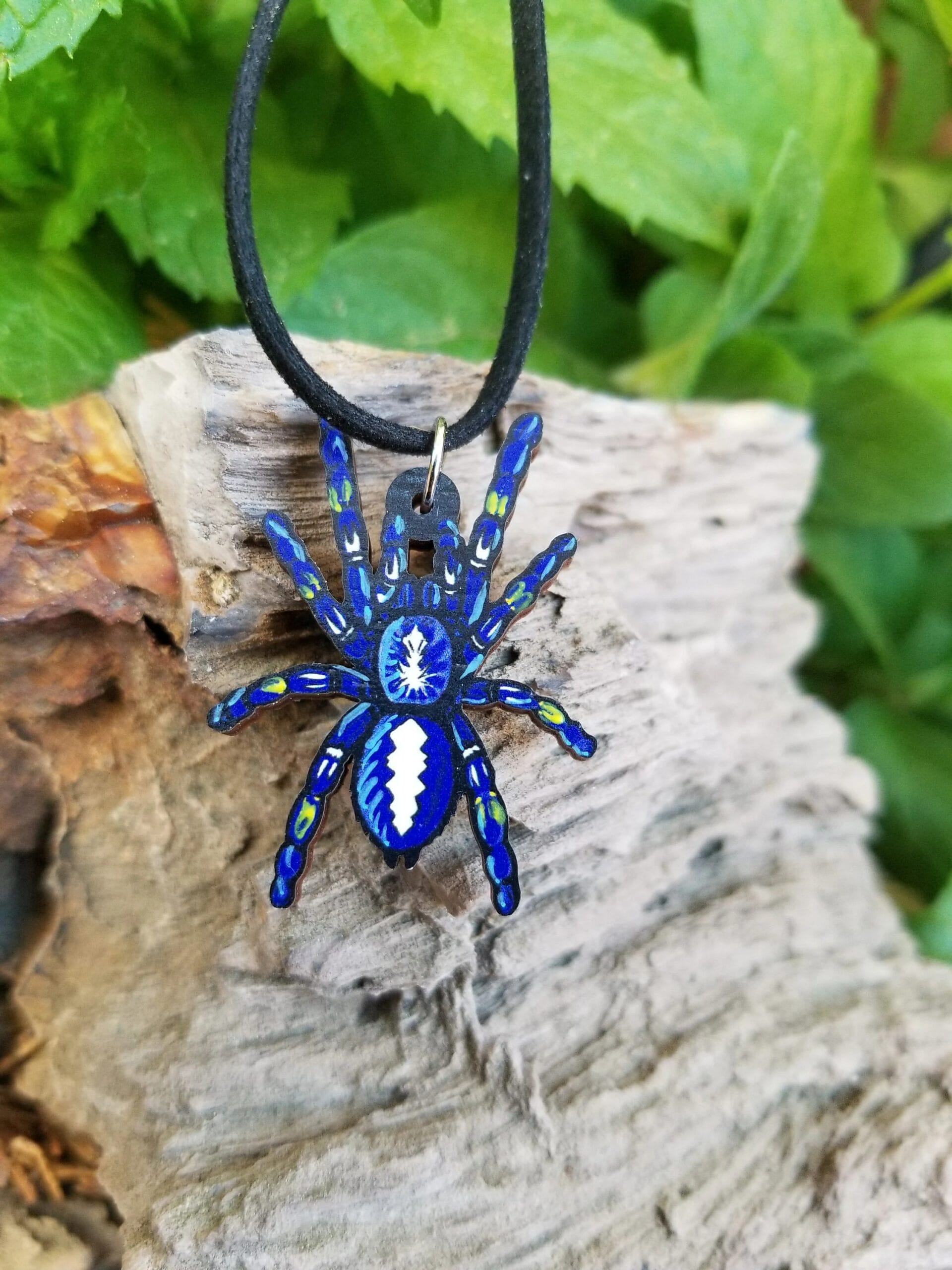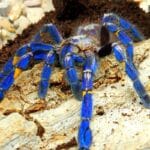Imagine a spider shimmering like a sapphire nestled within the emerald embrace of an Indian forest. This isn’t a figment of imagination, but the breathtaking reality of the Gooty Sapphire Ornamental (Poecilotheria metallica), a tarantula as captivating as it is critically endangered. This comprehensive guide delves into the fascinating world of this rare jewel, exploring its behavior, care requirements, and the crucial ethical considerations surrounding its ownership.
Unveiling the Sapphire of the Indian Forests
The Gooty Sapphire Tarantula, also known as the Gooty Sapphire, Metallic Tarantula, or Peacock Parachute Spider, hails from the dry deciduous forests of Andhra Pradesh, India. Its vibrant, metallic blue carapace, shimmering like a polished gemstone, is a product of intricate nanostructures that refract light, a phenomenon distinct from pigment-based coloration. This “nature’s nanotechnology” sets it apart, making it a highly sought-after species in the exotic pet trade, unfortunately contributing to its endangered status.
Habitat and Appearance: A Jewel in the Forest Canopy
This arboreal species resides in the hollows of tall trees, spinning asymmetrical funnel webs that serve as both home and hunting grounds. Their natural habitat, restricted to a small area within Andhra Pradesh, is shrinking rapidly due to deforestation and human encroachment, further jeopardizing their survival. Adult Gooty Sapphires typically reach a leg span of 6-8 inches, with females generally larger and more robust than males.
Diet and Behavior: A Swift Hunter in the Trees
The Gooty Sapphire’s diet consists primarily of flying insects, such as crickets and moths, which it ambushes with lightning-fast speed from its arboreal vantage point. While generally solitary creatures, observations suggest they may exhibit communal behavior in the wild under certain circumstances, a phenomenon currently under research.
Venom and Defense: A Powerful Deterrent
While not lethal to humans, the Gooty Sapphire possesses medically significant venom. A bite can induce intense pain, muscle cramps, headaches, nausea, and localized swelling, with symptoms potentially persisting for days, weeks, or even months. Medical attention is highly recommended following a bite. Unlike New World tarantulas, they lack urticating hairs, relying instead on their speed and venom for defense.
Conservation Status: A Species on the Brink
The Gooty Sapphire Tarantula is classified as Critically Endangered by the IUCN, signifying a very high risk of extinction in the wild. Habitat loss due to deforestation and the illegal pet trade are the primary threats to its survival. Ongoing research and conservation initiatives are crucial for protecting this remarkable species and its fragile habitat.
Captive Care: A Serious Responsibility
Owning a Gooty Sapphire Tarantula is not for the faint of heart. Their demanding care requirements, coupled with their potent venom and skittish nature, make them suitable only for experienced keepers.
Enclosure Setup: Recreating the Forest Canopy
A tall, well-ventilated terrarium with ample climbing opportunities using branches, cork bark, and other natural materials is essential. Maintaining a humidity level between 70-80% is crucial to replicate their natural environment.
Temperature and Substrate: Creating a Microcosm of India
A temperature gradient between 75-85°F allows the tarantula to thermoregulate. A moisture-retaining substrate, such as coco fiber or a blend of coco fiber and peat moss, helps maintain appropriate humidity.
Diet and Feeding: Catering to an Insectivore
A diet of live, appropriately sized flying insects, primarily crickets and moths, is essential. Avoid overfeeding, which can lead to health issues.
Handling: Observation Over Interaction
Handling a Gooty Sapphire is strongly discouraged. Their speed, delicate nature, and potent venom make handling risky. Appreciate their beauty through observation, not interaction.
| Factor | Description |
|---|---|
| Enclosure | Tall, well-ventilated terrarium with ample climbing opportunities (branches, cork bark). |
| Substrate | Moisture-retaining (e.g., coco fiber, peat moss mix). |
| Temperature | 75-85°F (gradient). |
| Humidity | 70-80%. |
| Diet | Primarily flying insects (e.g., appropriately sized crickets, moths). |
| Handling | Not recommended; observe, don’t interact. |
The Ethics of Ownership: A Critical Consideration
Given its Critically Endangered status, the decision to own a Gooty Sapphire Tarantula requires careful ethical consideration. Is it right to keep such a rare and vulnerable creature in captivity? Supporting conservation efforts and responsible captive breeding may be a more ethical approach than acquiring a wild-caught individual. Captive-bred individuals offer a sustainable alternative, reducing pressure on wild populations. However, even with captive-bred specimens, providing optimal care requires extensive knowledge, resources, and commitment.
Intrigued by the captivating world of gargoyle geckos? Discover the fascinating symbolism behind greenery symbolizing victory and its rich history.
Ongoing Research and Future Directions
Research continues to unveil the intricacies of the Gooty Sapphire Tarantula’s behavior, venom composition, and the complexities of its structural coloration. These ongoing studies are invaluable for developing effective conservation strategies and ensuring the long-term survival of this mesmerizing species. The future of the Gooty Sapphire rests in our hands. By prioritizing habitat preservation, combating the illegal pet trade, and promoting responsible captive breeding, we can help safeguard this living jewel for generations to come.
- Discover Trasa Robertson Cobern’s Mentors: Shaping Her Hurst Campaign - July 9, 2025
- Discover People Influenced by Trasa Cobern: A Legacy of Service - July 9, 2025
- Discover Trasa Cobern’s Nonprofit Impact: A Deep Dive - July 7, 2025
















